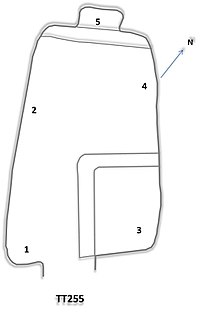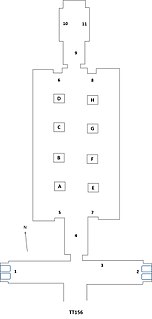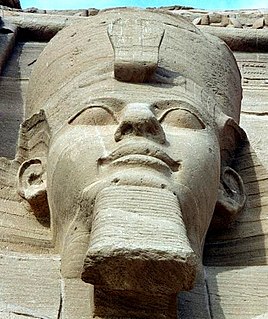The necropolis of Dra' Abu el-Naga' is located on the West Bank of the Nile at Thebes, Egypt, just by the entrance of the dry bay that leads up to Deir el-Bahri, and north of the necropolis of el-Assasif. The necropolis is located near the Valley of the Kings.

El-Assasif is a necropolis on the West Bank at Thebes, Egypt, Upper Egypt. It is located in the dry bay that leads up to Deir el-Bahri, and south of the necropolis of Dra' Abu el-Naga'.

Sekhemre-Wepmaat Intef was an Egyptian king of the Seventeenth Dynasty of Egypt, who lived late during the Second Intermediate Period, when Egypt was divided into two by Hyksos controlled Lower Egypt and Theban ruled Upper Egypt.

Ahhotep I was an Ancient Egyptian queen who lived circa 1560–1530 BC, during the end of the Seventeenth Dynasty of Egypt. She was the daughter of Queen Tetisheri and Senakhtenre Ahmose, and was probably the sister, as well as the queen consort, of Pharaoh Seqenenre Tao ll. Ahhotep I had a long and influential life. She ruled as regent for her son Ahmose I for a time.

Ahhotep II was an Ancient Egyptian queen, and likely the Great Royal Wife of Pharaoh Kamose.
The Theban Tomb TT11 is located in Dra' Abu el-Naga', part of the Theban Necropolis, on the west bank of the Nile, opposite to Luxor. It is the burial place of the Ancient Egyptian Djehuty, who was Overseer of Treasury and of Works, during the 18th Dynasty reign of Hatshepsut.

The Theban Tomb TT12 is located in Dra' Abu el-Naga', part of the Theban Necropolis, on the west bank of the Nile, opposite to Luxor. It is the burial place of the Ancient Egyptian Hery, who was Overseer of the Granary of the King's Mother Ahhotep, during the reigns of Seqenenre Tao II to Amenhotep I.

The Theban Tomb TT255 is located in Dra' Abu el-Naga'. It forms part of the Theban Necropolis, situated on the west bank of the Nile opposite Luxor. The sepulchre is the burial place of the Ancient Egyptian Roy, who lived at the end of the 18th dynasty, during the reign of Horemheb.

Setau was the Viceroy of Kush in the second half of Ramesses II's reign. Contemporary records show that Setau served in this position from Year 38 until at least Year 63 of Ramesses II's reign. Setau was "a graduate of the royal school" and already enjoyed an impressive record of royal service which is detailed in a long autobiographical inscription carved at Wadi es-Sebua. The temple of Wadi es-Sebua was built for Ramesses II by Setau around 1236 BC or Year 44 of this pharaoh's reign. Eleven of his stela, now in the Cairo Museum, were found in the courtyard of this temple and make it possible to establish his career and understand the precise duties of a viceroy. Setau states:
Ahmose called Turo was Viceroy of Kush under Amenhotep I and Thutmose I.

Amenemopet served as Viceroy of Kush during the reign of Seti I.
Heqanakht was Viceroy of Kush during the reign of Ramesses II. His titles include: King's son of Kush, overseer of the Southern Lands, Fan-bearer on the Right Side of the King, Messenger to every land, Hereditary prince, royal sealbearer.
Paser II was the son of the High Priest of Min and Isis named Minmose. Paser came from a very well-connected family. One uncle was the High Priest of Amun Wennenefer and another uncle was the troop commander of Kush named Pennesuttawy. Through Wennenefer, Paser was related to Amenemone, Amenemope and Hori, the High Priest of Anhur.
Maya or May was a High Priest of Amun of Ancient Egypt, until at least year 4 of Akhenaten.

Amenhotep was the High Priest of Amun towards the end of the Twentieth Dynasty of Egypt, serving under Ramesses IX, Ramesses X and Ramesses XI. He was the son of Ramessesnakht, the previous high priest of Amun. It is not beyond dispute who succeeded him in office. For a long time it was assumed that he was followed by the High Priest Herihor. However, Karl Jansen-Winkeln has suggested that Amenhotep was instead succeeded by the High Priest Piankh. We know the names of several of his brothers and a sister:
Neferhotep was an Ancient Egyptian official with the title scribe of the great enclosure. He lived during the 13th Dynasty, around 1750 BC. His tomb was found in 1860 by Auguste Mariette in Dra Abu el-Naga and contained an important range of objects, most notably of which was the Papyrus Boulaq 18 which is an account of life in the Theban palace. The papyrus had already been published, but the finds in Neferhotep's tomb have only recently been fully published. The tomb contained the rishi coffin of Neferhotep, which was most likely badly decayed when Mariette found it. So it is only known from Mariette's description. Other finds in the tomb are a walking stick, a head rest, a faïence hippopotamus, wooden pieces of the Hounds and Jackals game, a mace, writing implements, a wooden tray for a mirror, two calcite vessels, a magical wand and a double scarab.

The Theban Tomb TT156 is located in Dra' Abu el-Naga', part of the Theban Necropolis, on the west bank of the Nile, opposite to Luxor. It is the burial place of the Ancient Egyptian Pennesuttawy who was a troop commander and superintendent of the Southern Desert Lands during the reign of Ramesses II in the Nineteenth Dynasty.
The Theban Tomb TT282 is located in Dra' Abu el-Naga', part of the Theban Necropolis, on the west bank of the Nile, opposite to Luxor. It is the burial place of the Ancient Egyptian Nakhtmin, also called Nakht, who lived during the 19th dynasty, during the reign of Ramesses II.
Nakhtmin was a Troop Commander of Kush and Royal Envoy to Every Foreign Land during the reign of Ramesses II.










